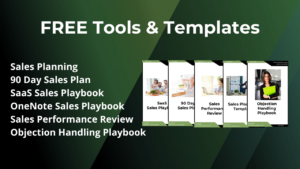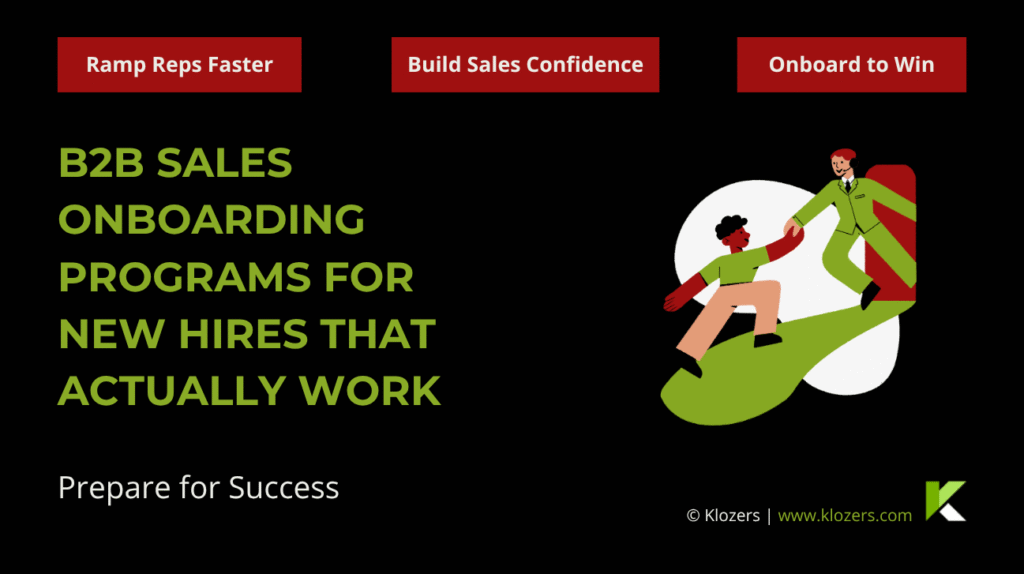What are the 4 C’s for onboarding - Top Question From Google:
The 4 C’s of onboarding are Compliance, Clarification, Culture, and Connection. These are the pillars that help your new hires transition smoothly into a new role. Compliance covers legal and procedural setup. Clarification ensures role expectations are clear. Culture helps them understand how things are done at the company. And Connection makes sure they build meaningful relationships from day one.
Free access to our best tools and templates
Introduction: B2B sales onboarding programs
In B2B sales, first impressions are incredibly important. When new reps join the team, the way they’re welcomed, trained, and supported can have a direct impact on how quickly they ramp up, how well they perform, and how long they stay. Yet many organizations still rely on outdated or informal onboarding processes, expecting new hires to figure it out as they go.
That approach doesn’t work in B2B sales settings. B2B selling is complex, with long sales cycles, specialized tools, and sophisticated buyers. Reps need more than enthusiasm to succeed. They need guidance, clarity, and a sense of connection. That’s where a thoughtful, well-structured onboarding program comes in.
In this guide, we’ll explore what makes B2B sales onboarding effective, from compliance basics to culture and coaching. Whether you’re designing a program from scratch or improving what you already have, these principles will help you set your team up for success.
Why B2B sales onboarding needs a strong framework
Getting up to speed in B2B sales is no small task. Reps have to learn about your product or service in depth, understand the market, use CRM tools efficiently, and build relationships with leads who may have already done hours of independent research. All of this happens under the pressure of early performance targets.
Without a solid onboarding framework, new hires are left guessing. That leads to confusion, poor early performance, and higher turnover, all of which affect your bottom line. On the other hand, a structured onboarding program helps reps feel confident, connected, and ready to contribute.
The numbers speak for themselves: organizations with a strong onboarding process improve new hire retention by up to 82% and productivity by over 70% (Harvard Business Review). Simply put, great onboarding drives better outcomes for individuals and the business.
The 4 C’s of the sales onboarding program and what they mean
An effective onboarding process is a journey that introduces your reps to the tools, expectations, people, and culture of your organization.
Below are the five core pillars of a strong program.
Compliance: Get the basics out of the way fast
Every onboarding program needs to start with the basics, but the goal here is to make this part seamless, not slow. Reps should quickly receive access to tools, systems, and accounts they’ll use every day. Legal documentation, internal policies, and data compliance protocols should be covered early, ensuring reps understand the boundaries they’ll work within.
This stage isn’t glamorous, but it’s important. When done well, it clears the path so reps can focus their energy on learning how to sell, not waiting for system logins or chasing HR paperwork.
Clarification: Define the role clearly
Once the setup is complete, the next step is clarity. New reps need to understand what they’ll sell and what is expected of them. That means clearly defining:
- What success looks like (KPIs, quotas, milestones)
- Their target market and buyer personas
- Their territory (geographic, vertical, or account-based)
- Key tools and daily workflows (CRM, sales enablement platforms, etc.)
Giving reps this structure early helps reduce uncertainty and builds a sense of purpose. Many companies benefit from using a process-first onboarding model, where reps learn the exact steps involved in discovery calls, demos, follow-ups, and closing. This reduces the need for trial-and-error and accelerates performance.
Culture: Help them understand the “how”
Culture can be harder to teach than systems, but it’s just as important, especially in hybrid or remote teams. Every sales organization has its own rhythm: how people communicate, when meetings happen, how feedback is given, and what’s celebrated.
Help new hires absorb this by assigning mentors, encouraging participation in team huddles, and including them in informal Slack channels or coffee chats. The goal is to help them feel like part of the team early, so they’re more likely to ask questions, share challenges, and stay engaged.
If your company has specific values, rituals, or traditions, whether it’s Friday wins, monthly demos, or internal awards, this is a great time to showcase them.
Connection: Don’t let them drift
Sales rarely work in a vacuum. Your reps will interact with marketing, product, operations, customer success, and more. Giving them opportunities to connect with these teams early helps them see the bigger picture and ask smarter questions.
This could look like:
- Intro sessions with marketing to understand campaign goals
- Briefings from product managers on upcoming releases
- Ride-alongs with customer success reps
- A welcome message from the CEO or leadership team
These interactions reinforce that sales is part of a broader ecosystem, and that everyone is working toward shared goals.

Sales-specific training and practice
This is the heart of the onboarding experience. Once foundational topics are covered, it’s time to dig into real sales training. This includes:
- Product immersion: Encourage hands-on experience. Reps should see, use, and test the product the way a customer would, not just read about it in a deck.
- Process walkthroughs: Use real examples from your pipeline to walk through a full deal cycle. Reps should understand what happens at every stage, what materials to use, and what signals to watch for.
- Objection handling: Equip reps to manage pushback with confidence. Practice sessions, peer role-plays, and recordings of top performers can help build this skill quickly.
- CRM training in context: Avoid siloed tech modules. Instead, teach the CRM as reps build their pipeline or log calls. This makes the tool relevant and memorable.
Measuring onboarding success
Completing onboarding doesn’t mean a rep is fully up to speed. That’s why it’s important to track progress with both data and feedback. Key metrics to monitor include:
- Time to first deal
- Pipeline activity by the end of week 4
- Quota attainment within the first 90 days
- Satisfaction surveys from new hires
- Qualitative manager feedback from shadowing or coaching sessions
Beyond metrics, regular check-ins make a big difference. Managers should ask new hires where they feel confident and where they feel stuck. These conversations surface gaps in the program that can be improved for future hires.
Organizations with strong onboarding cultures see onboarding as a living process, one that evolves based on real input, not just checklists.
Scaling without losing the human touch
As your sales team grows, it’s tempting to streamline everything into an automated course. And while automation has its place, onboarding should never feel like a one-size-fits-all box to check.
Some elements can and should be standardized:
- Recorded product demos
- Sales playbooks
- Onboarding checklists and FAQs
- CRM walkthrough videos
But others need to stay personal:
- One-on-one coaching
- Personalized feedback on early calls
- Territory planning and goal-setting sessions
- Shadowing with senior reps
Many successful companies use a hybrid approach, combining self-paced modules with scheduled group sessions, mentorship calls, and live workshops. This model gives new hires flexibility while still keeping them connected to the team and leadership.
Onboarding as a strategic advantage
An effective onboarding process drives long-term success.
When reps are supported from day one, they feel more capable, more connected, and more motivated. That translates into stronger results, better customer relationships, and higher retention.
The most effective programs will inform, build clarity, and foster real connection without overwhelming your new reps.
When you’re designing or updating your onboarding strategy, remember that you’re also shaping confidence, trust, and performance. Get it right, and your reps won’t just learn faster, they’ll stay longer and sell better.
Actionable Tip
Use the 4 C’s—Compliance, Clarification, Culture, and Connection—as a framework to build onboarding that equips reps with clarity and confidence from day one.
Final Thoughts
B2B sales onboarding should be more than a checklist. It’s the foundation that shapes how quickly new hires ramp up, how confident they feel, and how long they stay. By building programs around the 4 C’s: Compliance, Clarification, Culture, and Connection. you create structure without losing the human touch. When reps are supported from day one, they learn faster, perform better, and become lasting contributors to the success of your sales organization.






